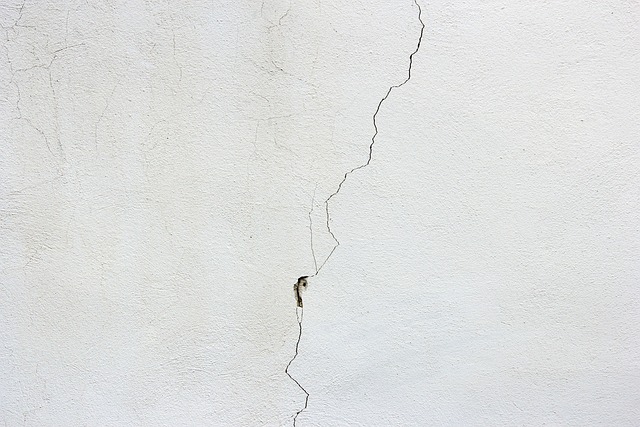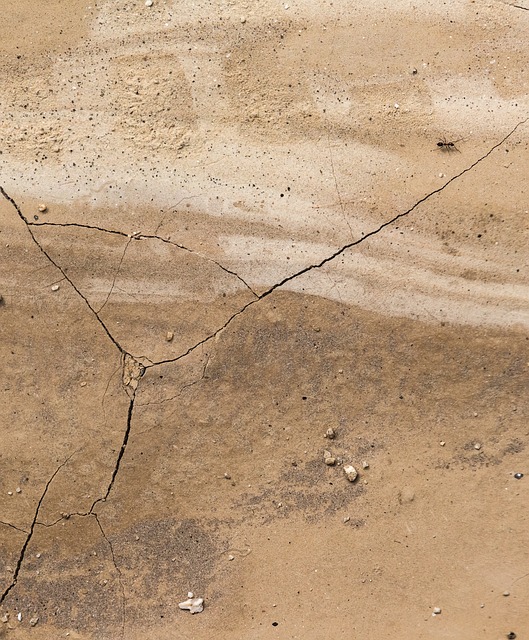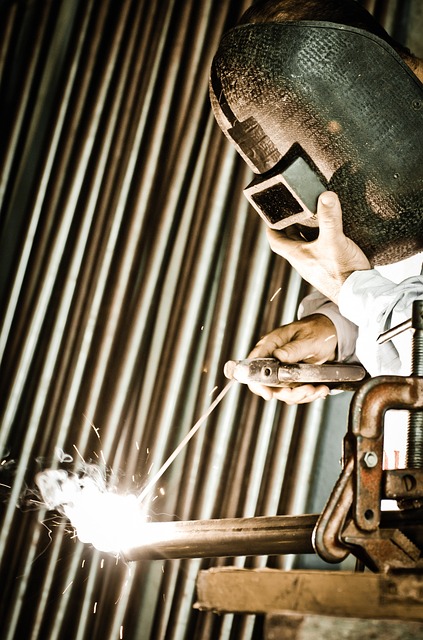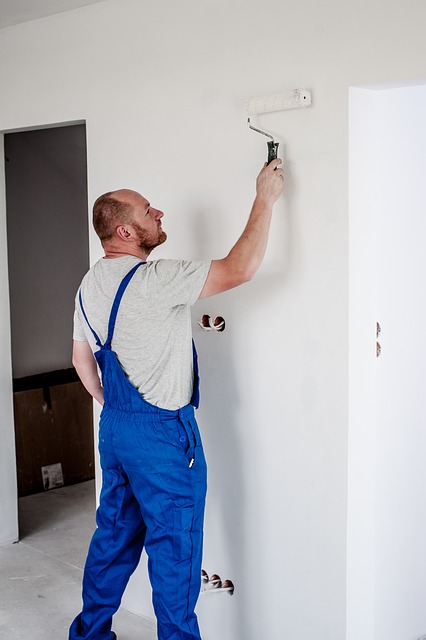Concrete waterproofing is essential to protect structures from moisture damage, extend lifespans, and preserve structural integrity. Key components include sealing pores, filling cracks, and repairing existing damage, particularly in regions with high rainfall or groundwater levels. Crack repair is vital as it prevents water intrusion and future structural issues. Effective methods include epoxy injections, polymer compounds, carbon fiber wrapping, and polymeric membranes. Choosing the right materials based on environmental factors ensures long-lasting protection. Regular inspection, proper surface preparation, and adherence to curing instructions are best practices for proactive crack filling and sealing. Mistakes like neglecting crack repair or using low-quality materials can compromise waterproofing. Advanced technologies offer more effective solutions with superior durability. Case studies demonstrate successful crack repairs in various concrete applications, emphasizing the importance of tailored waterproofing strategies.
Concrete waterproofing is a crucial aspect of maintaining robust and durable concrete structures. This essential process involves protecting concrete surfaces from moisture intrusion, which can cause significant damage and compromise structural integrity. Understanding the basics and recognizing common issues like cracks is vital for effective waterproofing. This article explores crack repair techniques, material selection, step-by-step guides, best practices, mistakes to avoid, and advanced technologies in concrete waterproofing, offering a comprehensive resource for both professionals and DIY enthusiasts tackling crack repairs.
Understanding Concrete Waterproofing: Basics and Importance

Concrete waterproofing is an essential process that protects concrete structures from moisture intrusion, which can cause severe damage over time. It involves creating a barrier to prevent water from penetrating the concrete surface, thus prolonging its lifespan and maintaining structural integrity. This technique is particularly crucial in regions with high rainfall or where ground water levels are elevated.
The basics of waterproofing include sealing the concrete’s porous nature, filling microscopic cracks that could allow water seepage, and addressing existing damage like cracks and holes. Crack repair, a critical aspect, ensures that even tiny fissures, often invisible to the naked eye, are sealed off. By doing so, it prevents water from finding its way into the concrete, thereby avoiding potential structural issues and costly repairs in the future.
Common Causes of Concrete Cracks and Their Impact on Waterproofing

Concrete cracks can arise from a variety of factors, each with its own implications for waterproofing integrity. One of the most common causes is structural stress resulting from changes in temperature and moisture levels. As concrete expands and contracts, it places strain on its surface and joints, leading to hairline fractures over time. Another frequent culprit is poor initial construction, including inadequate cement or aggregate quality, improper mix ratios, or subpar finishing techniques. These issues weaken the concrete’s bond, making it more susceptible to cracking under normal wear and tear.
Once cracks form, they can significantly compromise waterproofing efforts. Water can infiltrate through these fissures, reaching the rebar and interior surfaces, leading to corrosion and further structural damage. Moreover, cracks create pathways for moisture vapor to pass through, which can cause blistering and peeling of protective coatings. Prompt crack repair is crucial to mitigate these risks. By sealing and filling cracks with suitable materials, such as epoxy injections or polymer-based compounds, the lifespan of concrete structures can be extended, ensuring better long-term waterproofing performance.
Crack Repair Techniques: A Comprehensive Overview

Concrete structures, over time, can develop cracks due to various factors like settlement, environmental conditions, and structural stress. Implementing effective crack repair techniques is vital for maintaining the integrity and longevity of concrete surfaces. The first step in crack repair involves assessing the extent of damage, which determines the appropriate method to be employed.
There are several commonly used methods for repairing cracks in concrete. One technique is the use of epoxy injections, where a liquid epoxy resin is forced into the crack under pressure. This method is particularly effective for wider cracks and can provide a strong bond to stabilize the structure. Another approach is carbon fiber wrapping, which involves applying a layer of carbon fibers over the crack to reinforce it. This technique is often used for smaller cracks and offers an aesthetic benefit as well. For more extensive repairs, repairing concrete cracks with a polymeric membrane or a mortar mix can be effective, ensuring water doesn’t seep through and further weaken the structure.
Choosing the Right Materials for Concrete Waterproofing

When it comes to concrete waterproofing, selecting the appropriate materials is paramount to ensuring longevity and effectiveness. The first step involves understanding the unique requirements of your project, particularly in identifying potential areas prone to water penetration, such as cracks or joints. For crack repair, choosing a flexible yet durable waterproofing membrane or coating is key. These products can conform to the contours of concrete, filling and sealing cracks effectively, preventing water seepage, and ensuring structural integrity over time.
Material selection should also consider environmental factors. For instance, in regions with harsh climates, selecting materials that withstand freeze-thaw cycles and extreme temperatures is essential. Additionally, choosing waterproofers with anti-corrosive properties can extend the lifespan of your concrete structure by protecting it from damage caused by metal reinforcement bars. This meticulous material selection process forms a solid foundation for successful concrete waterproofing.
Step-by-Step Guide to Effectively Waterproof Concrete Surfaces

Waterproofing concrete surfaces is a process that involves several crucial steps, especially for crack repair and ensuring long-term protection. Here’s a comprehensive guide to help you effectively waterproof your concrete:
1. Inspection and Crack Repair: Begin by thoroughly inspecting the concrete surface for any cracks or defects. Use a hammer and chisel to carefully repair these cracks, ensuring they are cleaned and free from debris. Filling cracks with a suitable epoxy or polyurethane-based crack filler will create a solid foundation for waterproofing.
2. Surface Preparation: Next, prepare the concrete by sweeping away any dust and loose particles. Pressure washing can also be employed to thoroughly clean the surface. This step is vital as it ensures better adhesion of the waterproofing membrane or coating. Consider using a degreaser if there are oil stains or other contaminants present. After cleaning, allow the concrete to dry completely before proceeding.
3. Choose an Appropriate Waterproofing Method: Depending on your project’s requirements and environmental conditions, select the right waterproofing system. Options include applying a liquid membrane, coating with a waterproof sealer, or installing a sheet membrane. Each method has its advantages and should be chosen based on factors like durability, traffic, and exposure to moisture.
4. Application and Adherence: Follow the manufacturer’s instructions for applying the chosen waterproofing product. Ensure proper coverage and adherence by using the appropriate tools (e.g., brushes, rollers, or sprayers). For liquid membranes, a smooth finish is essential. In areas with high traffic or exposure to heavy loads, additional reinforcement may be necessary.
5. Curing and Drying: After application, allow the waterproofing material to cure as per the product’s guidelines. Curing ensures optimal adhesion and performance. Ensure proper ventilation during the drying process, especially for coatings and sealers. Most products will have specific time frames for curing and drying, so adhere to these instructions for best results.
Best Practices for Long-Lasting Concrete Protection

To ensure long-lasting concrete protection, adopting best practices for waterproofing is paramount. One crucial aspect is addressing cracks proactively through effective crack repair methods. Even minor cracks can expand and allow water penetration, leading to serious structural damage over time. Therefore, it’s essential to use high-quality sealants or coatings designed for concrete to fill and seal these gaps. Regular inspection and maintenance are also key; identifying and repairing cracks early prevents further deterioration and ensures the concrete remains in optimal condition.
Additionally, proper surface preparation is fundamental before applying any waterproofing treatment. This includes cleaning the concrete thoroughly to remove dirt, grease, and other contaminants that could hinder adhesion. Profiling or roughening the surface can enhance sealant bonding, enhancing overall waterproofing efficiency. By combining these best practices with high-performance products, you create a robust barrier against moisture, extending the lifespan of your concrete structures.
Common Mistakes to Avoid During Concrete Waterproofing Projects

Many concrete waterproofing projects fail due to common mistakes that can be easily avoided. One of the most frequent errors is neglecting crack repair. Cracks in concrete act as entry points for water, compromising the overall waterproofing effectiveness. It’s crucial to address these cracks before applying any waterproof membrane or coating to ensure long-term protection. Ignoring crack repair not only leads to future damage but also renders the entire project futile.
Another mistake is using subpar materials or improper application techniques. Using low-quality waterproof membranes or failing to follow manufacturer instructions can result in blisters, peeling, and eventual failure of the waterproofing system. It’s essential to invest in high-quality materials and closely adhere to best practices for optimal results.
Advanced Technologies in Concrete Waterproofing Solutions

In today’s digital era, advanced technologies have revolutionized concrete waterproofing solutions, offering more effective and durable methods than ever before. One prominent innovation is the use of sophisticated sealing agents and membranes designed to fill micro-cracks before they widen, effectively preventing water penetration. These cutting-edge materials are not only flexible and adaptable but also possess excellent resistance to chemicals and UV rays, ensuring long-lasting protection.
Additionally, modern technology has enabled precise crack repair methods. Advanced tools and techniques allow for the accurate detection of cracks, enabling professionals to address them proactively. This proactive approach involves the injection of special resins or foams that expand upon entry into the crack, filling it completely from within, thereby enhancing structural integrity and waterproofing effectiveness.
Case Studies: Successful Concrete Waterproofing Repairs

Successful crack repairs in concrete structures are numerous and well-documented, serving as compelling case studies for waterproofing effectiveness. In urban settings, where concrete is extensively used for buildings and infrastructure, preventing water ingress is paramount to avoid structural damage and costly maintenance. For instance, a recent project focused on repairing cracks in a multi-story car park. Using a combination of epoxy injections and strategic mesh reinforcement, the team successfully halted further cracking and ensured the structure’s longevity.
These case studies highlight the versatility of waterproofing solutions tailored for concrete. From residential foundations to industrial floors, each repair addresses unique challenges, demonstrating that with the right approach, even severe cracks can be effectively sealed. This not only preserves the integrity of the concrete but also offers a cost-efficient solution compared to complete structure replacement.
